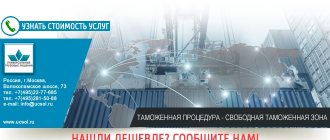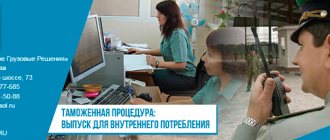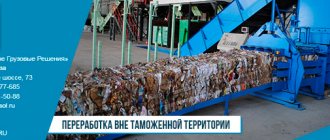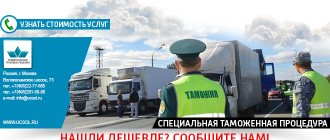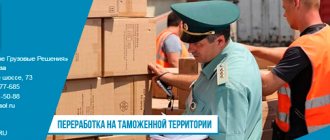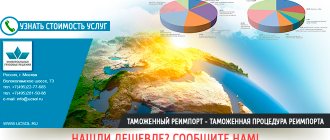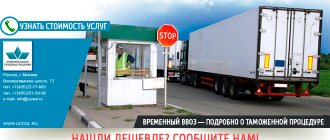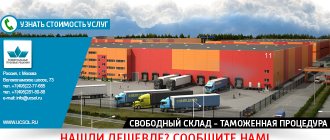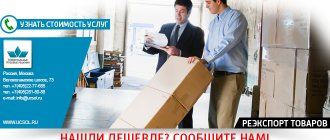HomeCustoms clearanceCustoms procedures Free customs zone
A free customs zone is a customs procedure (formerly: customs regime) applied on the territory of a Free Economic Zone - SEZ , and provides for the provision of registered participants in foreign economic activity (residents) with benefits in the payment of customs duties, taxes, special, anti-dumping, countervailing duties. FEZ residents are registered legal entities and individual entrepreneurs conducting economic activities in this territory. Another name applicable to free economic zones is Special Economic Zones (SEZ).
The customs procedure code for free customs zone is 78, it is indicated when filling out column 1 of the customs declaration by a legal entity or individual entrepreneur during electronic customs declaration.
If the goods are placed in a free customs zone, in column 1 you need to indicate IM 78 , and if the goods are exported from a free customs zone, then indicate EC 78 .
Example of filling out Column 1:
|
More details about filling
The main goal of the SEZ is to solve the problems of socio-economic development of certain territories of our country, or certain sectors of the economy through the targeted attraction of foreign investment, technology, and production. Enterprises operating in the territory of the FEZ are provided with tax benefits, as well as benefits on the payment of customs duties. Goods imported by them from abroad or from the rest of the territory of the Customs Union are exempt from the application of non-tariff regulation measures and customs control measures to them. There are 4 types of SEZ in the Russian Federation:
- Industrial and production;
- Technical and implementation;
- Tourist and recreational;
- Port.
They are located in different regions of the country: Altai Territory, Buryatia, Tatarstan, Astrakhan, Irkutsk, Kaluga, Lipetsk, Moscow, Pskov, Samara, Sverdlovsk, Tver, Tomsk, Tula and Ulyanovsk regions, as well as in Moscow, St. Petersburg. In total, there are 26 SEZs in Russia and work is constantly underway to open new ones. In 2021, the total number of SEZs in Russia was approaching 27.
Types of benefits
Benefits on taxes and fees.
The benefits that the state provides to residents of the FEZ depend on the type to which a particular free economic zone belongs.
- Residents of industrial and tourist zones are allowed accelerated depreciation;
- Residents of technical FEZs are allowed to establish reduced insurance premiums;
- Operations and services of port zone residents are not subject to VAT.
Benefits for the payment of customs duties and fees do not depend on the type of SEZ, but depend on the origin of the declared goods: for foreign goods one set of benefits for the payment of customs duties and fees is provided, for goods of the Customs Union - others, and for processed products (goods received in during the use of foreign goods and goods of the Customs Union) - third.
General benefits.
- For all residents, the tax rate on profit (that part of it that is credited to the budget of a constituent entity of the Russian Federation) has been reduced;
- Transport tax benefits (begin to apply from the moment of registration of transport in the territory of the FEZ);
- Exemption from land tax for a period of 5 to 10 years (the duration depends on the type of zone);
- For residents, the property tax is abolished if it is acquired within the boundaries of the zone, operates in the zone, or is created for unhindered work in the zone.
We remind you: tax and customs benefits are provided only to registered organizations - residents of the FEZ.
Territory of the free economic zone
The territory of a free economic zone is a place where a special favorable regime has been established for conducting commercial and other activities, which provides for the provision of various benefits and preferences. The customs zone procedure can only be used in the territory of Free Economic Zones . The procedure for applying the customs procedure of the “Free Customs Zone” , as well as the procedure for providing benefits for the payment of customs duties, is regulated by the provisions of the EAEU Labor Code and the Agreement between the Government of the Russian Federation, the Government of the Republic of Belarus and the Government of the Republic of Kazakhstan dated June 18, 2010 “On issues of free (special, special) economic zones on the customs territory of the customs union and the customs procedure of the customs zone.” The free customs zone regime is regulated by the provisions of the Federal Law of July 22, 2005 No. 116-FZ (as amended on July 18, 2017) “On Special Economic Zones in the Russian Federation,” as well as the relevant articles of the Tax Code. The territory of the free economic zone is a customs control zone and is equipped with everything necessary for this. Customs control is carried out over the goods placed on it and over their movement.
Contents of the free customs zone procedure
The content of the free customs zone procedure, as well as the conditions for placement under the procedure, are regulated by the FEZ Agreement.
The import of goods into the territory of the FEZ of foreign and EAEU countries is carried out without paying import customs duties, fees, duties and VAT.
Imported goods are placed on the territory of the SEZ under the procedure of a free customs zone . This involves, for example, the production and assembly of new goods from imported components or the processing of goods using imported equipment. As a result, a new product will be obtained that will have new properties and characteristics; its HS code, accordingly, must differ from the imported product.
Removal of goods from the territory of the FEZ. From the territory of the FEZ, goods can be exported to the EAEU or other states. Payments are then made.
Explanations to the EAEU Commodity Nomenclature for Foreign Economic Activity
Group 78
Lead and products made from it
Note:
1. The terms used in this group mean:
a) Rods - rolled, extruded, drawn or forged products, not rolled into coils and having a continuous continuous cross-section along the entire length in the form of circles, ovals, rectangles (including squares), equilateral triangles or regular convex polygons (including “flattened circles” and “modified rectangles”, the two opposite sides of which are convex arcs, and the other two sides are rectilinear, equal in length and parallel). Products with a rectangular (including square), triangular or polygonal cross-section may have corners rounded along the entire length of the product. The thickness of such products having a rectangular (including “modified rectangular”) cross-section exceeds 0.1 of their width. The term also applies to cast or sintered products of the same shape and size, subjected to processing after manufacture (other than simply trimming edges or removing scale), provided that they do not thereby acquire the distinctive features characteristic of products of other headings.
b) Profiles - rolled, extruded, drawn, forged or molded products, whether or not rolled into coils and having a constant cross-section throughout their entire length and not meeting the definitions of rods, wires, plates, sheets, strips or tapes, foil and pipes or tubes . The term also applies to cast or sintered products of the same shapes which have been subjected to treatment after manufacture (other than merely trimming or descaling), provided that they have not thereby acquired the distinctive features characteristic of products of other headings.
c) Wire - rolled, extruded or drawn products in coils and having a continuous cross-section along the entire length in the form of circles, ovals, rectangles (including squares), equilateral triangles or regular convex polygons (including “flattened circles” and “modified rectangles” , two opposite sides of which are convex arcs, and the other two sides are straight, equal in length and parallel). Products with a rectangular (including square), triangular or polygonal cross-section may have corners rounded along the entire length of the product. The thickness of such products having a rectangular (including “modified rectangular”) cross-section exceeds 0.1 of their width.
d) Plates, sheets, strips or strips and foil - flat products (other than unworked products of heading 78.01), whether or not rolled, and having a solid rectangular (other than square) cross-section, with or without rounded corners (including “modified rectangles”) ", the two opposite sides of which are convex arcs, and the other two sides are rectilinear, equal in length and parallel), with a constant thickness, having:
- rectangular (including square) shape with a thickness not exceeding 0.1 width;
- a shape other than rectangular or square, of any size, provided that they do not acquire distinctive features characteristic of products of other headings.
Heading 78.04 covers, inter alia, plates, sheets, strips or tapes and foils having a raised surface (for example, grooves, projections, checks, diamonds), as well as perforated, corrugated, polished or coated products, provided that At the same time, they did not acquire distinctive features characteristic of products of other headings.
e) Pipes and tubes are hollow products, rolled or not rolled into coils and having a constant cross-section with only one closed cavity along the entire length of the product in the form of circles, ovals, rectangles (including squares), equilateral triangles or regular convex polygons and having a constant wall thickness. Products with a cross-section in the shape of a rectangle (including a square), an equilateral triangle or a regular convex polygon, which may have corners rounded along the entire length of the product, should also be classified as pipes and tubes if their internal and external cross-sections are concentric and have one and the same shape and orientation. Pipes and tubes having the above cross-sections may be polished, coated, bent, threaded, drilled, tapered, flared, tapered, or have flanges, collars, or rings at their ends.
Note to subheadings:
1. As used in this chapter, the term "refined lead" means a metal containing not less than 99.9% by weight of lead, the content by weight of each other element not exceeding the limits specified in the following table:
Other elements
———————————————T——————————¬ ¦ Element ¦Limit content, wt.% ¦ +———————T———— ———+——————————+ ¦ Ag ¦ silver ¦ 0.020 ¦ +———————+———————+——————————+ ¦ As ¦ arsenic ¦ 0.005 ¦ +———————+———————+——————————+ ¦ Bi ¦ bismuth ¦ 0.050 ¦ +——————— +———————+——————————+ ¦ Ca ¦ calcium ¦ 0.002 ¦ +———————+———————+—————— ————+ ¦ Cd ¦ cadmium ¦ 0.002 ¦ +———————+———————+——————————+ ¦ Cu ¦ copper ¦ 0.080 ¦ +—— —————+———————+——————————+ ¦ Fe ¦ iron ¦ 0.002 ¦ +———————+———————+— —————————+ ¦ S ¦ sulfur ¦ 0.002 ¦ +———————+———————+——————————+ ¦ Sb ¦ antimony ¦ 0.005 ¦ +———————+———————+——————————+ ¦ Sn ¦ tin ¦ 0.005 ¦ +———————+———— ———+——————————+ ¦ Zn ¦ zinc ¦ 0.002 ¦ +———————+———————+——————————+ ¦Others (for example, Te), for each of them ¦ 0.001 ¦ L——————————————-+——————————
GENERAL PROVISIONS
This group includes lead and its alloys and some products made from them.
Lead is primarily extracted from galena, a naturally occurring lead sulfide that often contains silver. The crushed ore, after beneficiation by flotation, is usually roasted or sintered and then reduced by smelting. During firing or sintering, the sulfide is primarily converted to an oxide; During smelting, the oxide is reduced to lead by coke in the presence of flux. This produces rough or unrefined lead containing a number of impurities, often including silver. This lead is then typically further purified to produce high purity lead.
Lead can also be obtained by melting waste and scrap lead.
Lead is a heavy bluish-gray metal, it is characterized by high ductility, fusibility and softness (it leaves a mark when lightly pressed with a fingernail). It is characterized by resistance to most acids (for example, sulfuric or hydrochloric) and is therefore used in equipment for chemical plants.
Due to its low melting point, lead is easily alloyed with other elements. The main lead alloys that may be included in this group in accordance with section note 5 (see section general provisions) are as follows:
(1) Lead-tin alloys, used for example in lead-based soft solders, lead-tin coatings and tea packaging foils.
(2) Lead-antimony-tin alloys used for typesetting and in antifriction bearings.
(3) Lead-arsenic alloys used to make lead shot.
(4) Lead-antimony (solid lead) alloys used for bullets, battery plates, etc.
(5) Alloys of lead-calcium, lead-antimony-cadmium, lead-tellurium.
This group includes:
(A) Raw lead, waste and scrap lead (headings 78.01 and 78.02).
(B) Articles principally obtained by rolling or pressing raw lead of heading 78.01 (headings 78.04 and 78.06); lead powders and flakes (heading 7804).
(B) Pipes, tubes and fittings and articles falling in heading 78.06, which covers all other articles of lead other than those described in note 1 to the section or included in a group or more specifically named elsewhere in the Nomenclature.
Lead products and articles can be subjected to various types of treatments to improve the properties or appearance of the metal, etc. These treatments are usually the same as those described at the end of the general provisions of the group and do not affect the classification of the products.
The classification of composite products is given in the general provisions for section.
Conditions for placing goods under the free customs zone procedure
The conditions for placing goods under the free customs zone are indicated in the EAEU Labor Code . Here are some of them: the purpose of the goods is to be used by residents of the FEZ on its territory for commercial or other activities provided for in the agreement on the conditions for the functioning of the FEZ. Goods intended for placement in port or logistics SEZs can be placed by persons who are not residents of the SEZ, but who have entered into an agreement with them, while operations with goods should not lead to a change in their HS code and their characteristics. Foreign goods should not be subject to the prohibitions and restrictions provided for by the EAEU Labor Code, for example, fruits infected with the codling moth.
Under no circumstances can goods included in the list approved by law be placed under the procedure.
What does import customs regime 40 (IM 40) mean?
The department of customs clearance and customs control (CTO and TC) is responsible for the customs clearance procedure (placing goods under the customs procedure - release) to a greater extent than other control and risk management bodies involved in this process.
Goods are placed under the customs procedure for the following purposes::
- control of the product declaration with documents and declared information;
- checking goods for counterfeits and unfair production;
- vehicle inspections;
- in order to protect intellectual property.
In Russia, out of 17 types of procedures, the most popular and widespread is considered to be “Release of goods for domestic consumption” (import mode 40). Foreign products that have passed it can be used in the territory of the Customs Union without any restrictions.
The “import 40” regime involves the import of goods and services into the territory of Russia without the condition of re-export . Import clearance is a labor-intensive process where the main goal is to clear the cargo at customs and then transport it into the country.
Reference. Customs clearance is an important and urgent stage of foreign economic activity.
Distinctive features
The distinctive features of the IM 40 mode include:
- All goods crossing the border of the Customs Union (CU) must be carried out according to the appropriate procedure, in accordance with the rules established by the CU and Russian legislation.
- The release of goods (its placement under the customs procedure) is impossible without paying taxes, fees, as well as compliance with prohibitions, import restrictions and non-tariff controls.
- Only a resident (citizen of the Russian Federation) can declare cargo.
- Customs clearance is carried out only after customs has closed its delivery, when the goods are in a temporary storage warehouse (TSW).
- In Russia, all temporary storage warehouses, with the exception of aviation and maritime ones, are commercial. And the importer cannot submit a declaration without first concluding an agreement with a commercial warehouse (for non-commercial warehouses there is no such need).
- If the declarant submits a declaration for the first time in a new border zone, he must provide a certified package of constituent documents with the original certificate from the bank, documents on the lease of non-residential premises where the organization is legally registered.
- The status of the goods changes from foreign to goods of the Customs Union, but responsibility for compliance with the requirements for the use and (or) disposal of goods rests with the declarant.
Conditions for placing goods under IM 40
To place a load under IM 40, you need:
- pay duties and taxes (if no preferences or benefits are established for the goods);
- provide all the necessary documents for transportation under this regime;
- comply with non-tariff control on all restrictions and prohibitions regarding import and release issues;
- documentary evidence of payment of all duties, as well as compliance with special, protective, anti-dumping or countervailing measures.
According to Russian legislation, cargo under the import regime is released no later than the next day after the customs declaration is assigned a number in the absence of customs requirements for confirmation of codes and (or) confirmation of customs value. However, in reality, if a complete package of documents is available, the goods can be released on the same working day or even in a few hours.
Important! If the declarant responds to counter requests from customs authorities as quickly as possible, this will significantly speed up the process of accepting the declaration (that is, assigning a number to it), checking for non-tariff controls, prohibitions and restrictions, as well as accepting the customs value.
To submit a declaration, you need to convert all documentation into text electronic format . Originals or copies of documents are provided in electronic format in the form of pictures only at the request of the authorities. Therefore, without a specific set and the required form of documents or discrepancies in the data in the documents on the declared goods, the customs authority may refuse to accept and issue a customs declaration.
Services for registration of the “Free Customs Zone” procedure
Ours provides services to participants in foreign economic activity for declaring goods under the customs procedure “Free Customs Zone”, as well as under the procedures “Export” and “Release for domestic consumption” (import) for the further export of these goods from the territory of the FEZ. We work with all SEZs in the country.
We provide services to foreign trade participants:
- Legal entities
- For individual entrepreneurs
Documents and information for customs clearance of goods under the customs procedure Free customs zone (IM 78) or (EC 78)
- List of documents for registration of a Legal entity at customs (View)
- List of documents for registration of an individual entrepreneur at customs (View)
Do you need to complete the “free customs zone” procedure? – We will help you!
We are an official customs representative - a customs broker and are included in the appropriate register of the Federal Customs Service of the Russian Federation. Our customs declarants have extensive years of experience in customs clearance of goods under various customs procedures, including the “Free Customs Zone” customs procedure. You can trust us to declare goods of any complexity and volume. All necessary operations at customs will be performed efficiently and on time!
By trusting us, you can count on:
- Information and legal support on all related issues;
- Assistance in processing goods under the free customs zone procedure;
- Support during all customs operations, regardless of the type and specificity of the goods;
- Help in resolving controversial situations, no matter what caused them.
